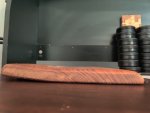I've had mixed luck with the wet it out theory. Sometimes it works.. sometime it doesn't. I give it relatively low odds given the grain on this one but you could try it (it might also cause the board to split, maybe 30-40% odds on that). Basically you're trying to get some moisture into the shrunk side while drying the not-shrunk side. But wood tends to shrink radially as it dries so you're piece is kind of the perfect example of that unfortunately.
The other thing you could try would be to boil it and clamp it very (VERY) slightly concave the opposite direction to dry. Boiling wood takes some of the ligen and plasticizes it which removes some of the tension and reduces long term movement. The downside is that it also boils out a lot of the color that I think you want in that piece.. so that may be less attractive for that reason. This is a technique used with some success by a lot of turners to reduce warping (less to remove warping though). The general plan is vigorous fully covered boil for 1 hour per inch of thickness, air dry. If you clamp it make sure you rig it up so there is good airflow on both sides otherwise it won't dry properly and it'll possibly be worse than it was.


